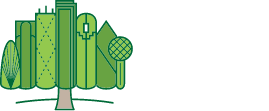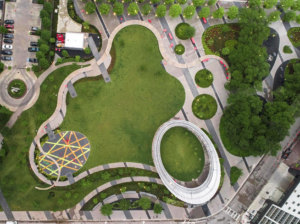They say good things come in small packages, and parks are no exception. Although we love a sprawling, amenity-rich green space just as much as anyone, sometimes a modestly appointed “pocket park” is all anyone needs to escape the hustle and bustle of urban life. Moreover, even though pocket parks typically only occupy between a quarter acre to a full acre of city land, like their larger counterparts, their impact is felt far and wide across the community.
Dallas is dotted with numerous pocket parks that are worth a visit the next time you’re looking to explore all our city has to offer.
Monarch Park (1823 N. Fitzhugh Ave.)
Monarch Park may only span a half-acre, but it certainly makes good use of its tight quarters. The park’s architects have managed to carve out space for a playground area, a sidewalk with benches, a small lawn, an outdoor basketball court and even two painted murals, so there’s plenty to do and see. Although Monarch Park is mostly located within a residential area, a quick half-mile jaunt is all it takes to discover the shops and restaurants lining the always-happening Lower Greenville Avenue.
Pegasus Plaza (1500 Main St.)
Located in the heart of Downtown Dallas, Pegasus Plaza’s amenities include one of the city’s more unusual water features: a hot spring fountain. To understand why, it’s useful to revisit the original Greek mythology surrounding the Pegasus, itself as established Dallas icon.
When the heroic Perseus defeated Medusa (a Gorgon with snakes for hair and a gaze that could turn lesser heroes into stone), the winged horse sprang from the blood of her severed head. From then on, wherever Pegasus struck the ground with its hoof, a spring burst forth. Sitting in the shadow of the Magnolia Building — once the city’s tallest skyscraper and the original perch of Dallas red neon Pegasus — it only makes sense that a fountain would feature prominently at a park named in this figure’s honor.
Moreover, the landscaping at Pegasus Plaza (the work of Brad J. Goldberg) includes elements that echo ancient labyrinths. In other words, there are quite a few ideas packed into this otherwise modest 0.5-acre space. The result is a fascinating, almost literal oasis punctuating Downtown’s urban density.
Harrell Park (1966 Abrams Pkwy.)
Lakewood and Old East Dallas are home to several pocket parks, including the Abrams Road Triangles and David R. & Mayme Graham Park, the latter of which serves as something of a gateway to the private grounds of the Lakewood Country Club. Just to the northwest, however, you’ll find a circle of benches shaded by tall Texas oaks — what the city of Dallas calls “a 0.75-acre special use area” and what residents of the surrounding neighborhoods know as Harrell Park.
Former druggist E.C. “Doc” Harrell is widely considered to be the “Father of Lakewood,” and his pharmacy was long an anchor of the Lakewood shopping center that also houses the iconic Lakewood Theater. Since 1980, this pocket park has been a place for residents of and visitors to East Dallas to take a moment and reflect. On a crisp autumn evening, it’s a great outdoor spot to sit an enjoy a cup of coffee (or hot chocolate) and some after-dinner conversation.
Stone Park (810 North Edgefield Ave.)
Stone Park, first established in 1971, gets an honorable mention on this list because, well, it’s extremely small. Coming in at just .1 acres, it’s by far the tiniest park on this list. Stone Park is located within a residential neighborhood, and if you came across it, it’s likely you wouldn’t even know you’d just walked an area designated for public use. This space sports exactly one bench and is nestled a mere .3-mile stroll away from the already pedestrian-friendly Bishop Arts District in Oak Cliff.
James W. Aston Park (1919 Pacific Ave.)
James W. Aston Park, or more commonly called Aston Park, is another green space located in Downtown. It sits on a .4-acre triangle whose sides are formed by Pacific Ave., Harwood St. and Live Oak St. The park consists of a plaza surrounded by a mature grove of trees. It was dedicated to prominent businessman James W. Aston in 1983, and a medallion with his name can be found at the entrance of the park. Pacific Plaza, which has already broken ground and is slated to be completed at the end of 2019, includes Aston Park as part of its design and will redub it Aston Grove.
Do you live near one of Dallas’ pocket parks? There might be one in your own neighborhood! Share your discoveries with us on Facebook, Instagram and Twitter.





